|
Snapshots
16-30
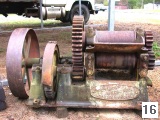 This mill (Slide 16)
had cast on one side "Columbus No. 18" and, as shown, had a bolt-on plate on
the opposite side that indicated Southern Plow Co. This large power mill was
found in Norman Park, Georgia. This mill (Slide 16)
had cast on one side "Columbus No. 18" and, as shown, had a bolt-on plate on
the opposite side that indicated Southern Plow Co. This large power mill was
found in Norman Park, Georgia.
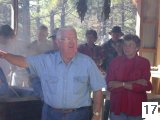 Don and Carol Dean (Slide 17) stand
in the steam of a kettle of syrup at one of their cane grinding days at Don's
heritage farm. Don and Carol Dean (Slide 17) stand
in the steam of a kettle of syrup at one of their cane grinding days at Don's
heritage farm.
Postscript. It is with profound regret that I note
the passing of Don in March, 2008. A brief biography from his services is
posted here. Don was a friend, generous to a fault. Certainly, all who
knew Don would gladly recall his or her favorite story or stories. As a
starter, my favorite would be his cutting a truck plus a trailer of cane and
driving it to Tallahassee--all as a gift to me. . . . or answering endless
trivial questions about cane mills. . . .or copying and sending me
out-of-print literature. Don was a leader and the founding president of
the Southern Syrupmaker's Association; I last saw him at our 2007 annual meeting at the
Pandhandle Pioneer Settlement and
photographed him addressing our group. Don's passion for syrupmaking and cane
mills culminated in a unique and priceless resource, The American Cane Mill, which was
published posthumously and which I heartily recommend to any cane-mill
enthusiast. Don was a rare individual, leaving many to mourn his death and
miss his guiding hand.
Ruby Dorminey (Enigma, Georgia) inherited this mill
(Slide 18) through Jake McMillan. As I understand it, it
was never in heavy use, being only used to make syrup that was fed, along
with sweet potatoes, to the hands who worked the farm. The mill is a
Goldens' No. 14 (New Model), a large two-horse two-roller enclosed mill that
weighs 835 pounds and was advertised to have a juice output of 70 gallons per
hour. (Thanks to Ken Christison for the specifications and Mr. J. L.
McMillan for historical information.)
-t.jpg) -t.jpg) Ken and Connie Christison
(Slide
19) make sorghum syrup in Conway, North Carolina. Ken’s
knowledge about old equipment and almost everything else is intimidating.
He’s an amazing fellow! I’ve gained more than I could
explain from our internet friendship over the past few years.
Noah Clayton Ralerson headed one of the four
original pioneer families who moved into Osceola County, Florida. His
family settled near present day Holopaw, Florida. That was convenient
because it was near a mail drop on the pike that connected Fort Drum and
Fort Christmas. That property has been passed down through the ages
and thus remains in the family. New blood from the north, Ralph
Kaschai, married into the family. The Kaschai family has a dwelling on
the property, and both Ralph and his son, Cash, are retired.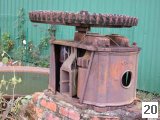 They have collected cane
mills for more than a decade and have two especially well-preserved ones (a
Columbus No. 18 and, my favorite, a Kentucky No. 0 [which has a patent date
of 1877]); I was very happy to be able to buy a Goldens' No. 2 (Old Style)
mill from them. Their family mill was a Victor No. 2 (Slide
20). Although it has been moved from its original location, Cash
set it up as his grandfather had used it. The mill was mounted low and
emptied directly into a kettle, the bottom of which was cemented in
place. The fire was then simply built around the kettle. Although
I have seen scores of historical sugar-cane syrup operations, this is the
first that I have seen with a kettle fired in this manner. The syrup
was used for family consumption and for moonshine. They have collected cane
mills for more than a decade and have two especially well-preserved ones (a
Columbus No. 18 and, my favorite, a Kentucky No. 0 [which has a patent date
of 1877]); I was very happy to be able to buy a Goldens' No. 2 (Old Style)
mill from them. Their family mill was a Victor No. 2 (Slide
20). Although it has been moved from its original location, Cash
set it up as his grandfather had used it. The mill was mounted low and
emptied directly into a kettle, the bottom of which was cemented in
place. The fire was then simply built around the kettle. Although
I have seen scores of historical sugar-cane syrup operations, this is the
first that I have seen with a kettle fired in this manner. The syrup
was used for family consumption and for moonshine.
Ronald Pascal (Metasville, Georgia) uses this
Goldens' No. 2 (New Model) (Slide 21) in his sorghum operation. Although this
photograph does not reveal it, this mill is in perhaps the best shape of any
unrestored mill that one will find.
-t.jpg) 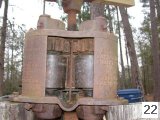
The Pioneer
Museum (Troy, Alabama) is an outstanding complement to the Agrirama, which is covered more extensively on
this website.
The Pioneer Museum has a comprehensive inside display, covers a somewhat
longer period, and the outside display is, in general, of a more primitive
era. Both of these sites are terrific and both are irreplaceable
assets; together, they provide visitors an important window into our
past. Before I visited this museum, I had considered only two kinds of
Chattanooga No. 12s, viz. the original
and the Improved, which was patented in 1890. As I have mentioned
before, behind Goldens' No. 2 (New Model), the Chattanooga No. 12 (Improved)
appears to have been the most popular mill in South Georgia and North
Florida. According to my previous observations, the Chattanooga No. 12
(Improved) has a juice spout cast underneath the base plate (as Page 3 of the
1919
catalog). Here (Slide 22), I noticed that this Chattanooga No. 12
(Improved) had a juice spout that was formed from a channel in the base plate
(i.e., similar to the Chattanooga No. 12 (Old Style) and the Goldens' No. 2
(Old Style and New Model). I put this problem first to Ken Christison,
who found a repair manual (probably from 1913) that showed the style of base
plate here. That manual also carried a footnote that indicated that
“Improvements involving changes have been made in our mills from year
to year . . . .” In the end, sleuthing by Don Dean and Ken
Christison seems to put this mill as a “Second Series” of the
Chattanooga No. 12 (Improved). All Chattanooga No. 12s manufactured
after 1905 were of the pattern that one normally sees (as mentioned, with the
juice spout under the base plate). Thanks to Ken and Don for sharing
their encyclopedic knowledge.
-t.jpg) Even with the fancy feedbox missing, the Kentucky
No. 0 is as cute as a bug's ear (Slide 23). From the Kaschai collection (see Slide
20), this mill has a patent date of 1877, though some small details
(shape of journal lids and top-plate reinforcements; perspective of lever
cap) differ from the patent illustration. (Thanks to Ken Christison for the
patent information.) As usual, Don Dean was able to supply interesting
information, some of which is incorporated into the remaining narrative. The
parent company was founded in 1855 in Louisville, KY, and went through
several management and name changes, finally being acquired in 1904 by
Blymyer Iron Works. A very recognizable name associated specifically with
this mill is Brennan and Co., which also made mills for Belknap Hardware.
This mill weighs only 400 pounds, had an advertised juice output of 33
gallons per hour, and cost $50 in 1877. It is slightly larger than a Goldens'
No. 1 (New Model), which weighs 375 pounds and cost $30 around 1916. (See
Ken's Catalog.) The rollers are one-half inches longer than
those of the Goldens' No. 1 (New Model), and the small rollers are one and
on-half inches larger in diameter. Although not shown on these views, the
bottom journals for the small rollers are adjusted in the normal way (i.e.,
with jamb nuts). A very uncommon aspect of this mill, however, is the
external square oil wells that are channeled to the lower bearings (See also
the Kentucky
No. 1). (Thanks to Jerry Patrick, who owns a similar mill and provided
photographs of the disassembled lower plate.) As far as I am aware, only one
other mill, a type of Southern Plow (Thanks, Don!), has external oil
channels. For an inside view of this mill, go to the patent
office and search for patent 192076. Even with the fancy feedbox missing, the Kentucky
No. 0 is as cute as a bug's ear (Slide 23). From the Kaschai collection (see Slide
20), this mill has a patent date of 1877, though some small details
(shape of journal lids and top-plate reinforcements; perspective of lever
cap) differ from the patent illustration. (Thanks to Ken Christison for the
patent information.) As usual, Don Dean was able to supply interesting
information, some of which is incorporated into the remaining narrative. The
parent company was founded in 1855 in Louisville, KY, and went through
several management and name changes, finally being acquired in 1904 by
Blymyer Iron Works. A very recognizable name associated specifically with
this mill is Brennan and Co., which also made mills for Belknap Hardware.
This mill weighs only 400 pounds, had an advertised juice output of 33
gallons per hour, and cost $50 in 1877. It is slightly larger than a Goldens'
No. 1 (New Model), which weighs 375 pounds and cost $30 around 1916. (See
Ken's Catalog.) The rollers are one-half inches longer than
those of the Goldens' No. 1 (New Model), and the small rollers are one and
on-half inches larger in diameter. Although not shown on these views, the
bottom journals for the small rollers are adjusted in the normal way (i.e.,
with jamb nuts). A very uncommon aspect of this mill, however, is the
external square oil wells that are channeled to the lower bearings (See also
the Kentucky
No. 1). (Thanks to Jerry Patrick, who owns a similar mill and provided
photographs of the disassembled lower plate.) As far as I am aware, only one
other mill, a type of Southern Plow (Thanks, Don!), has external oil
channels. For an inside view of this mill, go to the patent
office and search for patent 192076.
Terry Jarvis (Moultrie, Georgia) stands beside a
frameless mill (Slide 24) made
by Kehoe Iron Works (Savannah, Georgia). This mill is part of the "yard art"
that surrounds his expansive antique _(65)-t.jpg) collection, which is
one of the most interesting that I have seen. Terry takes antiques seriously:
in addition to more modern buildings, a vintage local cabin was moved onto
his site by a pond piece-by-piece. Even alone, this cabin is a museum, having
the oldest washing machine I have seen as well as a cooling board. Terry's
collection includes many odds and ends (e.g. a two-hole corn sheller, a
massive blacksmith bellows, a range of tools), but his personal focus is on
oil cans, turpentine equipment, and cast-iron cookware. His cookware
collection, numbering into the scores and dating back to the 1700s, is
stunning. collection, which is
one of the most interesting that I have seen. Terry takes antiques seriously:
in addition to more modern buildings, a vintage local cabin was moved onto
his site by a pond piece-by-piece. Even alone, this cabin is a museum, having
the oldest washing machine I have seen as well as a cooling board. Terry's
collection includes many odds and ends (e.g. a two-hole corn sheller, a
massive blacksmith bellows, a range of tools), but his personal focus is on
oil cans, turpentine equipment, and cast-iron cookware. His cookware
collection, numbering into the scores and dating back to the 1700s, is
stunning.
-t.jpg) John Evers (Norman
Park, Georgia) is a sideline antique dealer. This vertical power mill
(Slide 25) is one of the more interesting of his
collection. It had no markings that either John or I could find, but Keith
Kinney (who owned a Southern Plow) and Don Dean (who owns a Southern Plow
power mill similar to this one) were able to identify it as a Southern Plow.
Don also mentioned that some of these earlier mills did not have company
marks cast into the plates, but used bolt-on labels. This is indeed the case
of the two Southern Plow vertical mills that I own. John Evers (Norman
Park, Georgia) is a sideline antique dealer. This vertical power mill
(Slide 25) is one of the more interesting of his
collection. It had no markings that either John or I could find, but Keith
Kinney (who owned a Southern Plow) and Don Dean (who owns a Southern Plow
power mill similar to this one) were able to identify it as a Southern Plow.
Don also mentioned that some of these earlier mills did not have company
marks cast into the plates, but used bolt-on labels. This is indeed the case
of the two Southern Plow vertical mills that I own.
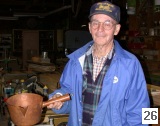 Paul Smith (Tallahassee, Florida) has a
lifetime collection of antiques, including some real jewels, as well as
everything else he has encountered. Of particular interest, he is shown
(Slide
26) here holding a syrup dipper with the inscription "D.H. & M. Co."
followed by what may be "Woosters, NY" or "Wooster St, NY." No solder was
used in the construction of the dipper and Mr. Smith places its manufacture
in the late 1700s. Paul Smith (Tallahassee, Florida) has a
lifetime collection of antiques, including some real jewels, as well as
everything else he has encountered. Of particular interest, he is shown
(Slide
26) here holding a syrup dipper with the inscription "D.H. & M. Co."
followed by what may be "Woosters, NY" or "Wooster St, NY." No solder was
used in the construction of the dipper and Mr. Smith places its manufacture
in the late 1700s.
-t.jpg) William J. Kehoe, an Irishman apparently with some
eccentricities, established his Kehoe Iron Works in Savannah, Georgia, in
1874. This photograph of his foundry (Slide 27) is identical to, but not copied from, a print at
Armstrong Atlantic University, where, as I edit this entry in
2008, my daughter is a professor.. His foundry made cane mills (e.g.,
Slide 24,
above) and kettles, the latter not being uncommon in the areas I visit.
Indeed, note the kettles in front of the building. Of course, the foundry
made a variety of items, such as this manhole
cover, all of which made him a wealthy man (his house, now
a toney bed-and-breakfast, a short history). To see an engraving of this beautiful
building, look at the company letterhead. (Thanks to Doug Croley for this
photograph!) William J. Kehoe, an Irishman apparently with some
eccentricities, established his Kehoe Iron Works in Savannah, Georgia, in
1874. This photograph of his foundry (Slide 27) is identical to, but not copied from, a print at
Armstrong Atlantic University, where, as I edit this entry in
2008, my daughter is a professor.. His foundry made cane mills (e.g.,
Slide 24,
above) and kettles, the latter not being uncommon in the areas I visit.
Indeed, note the kettles in front of the building. Of course, the foundry
made a variety of items, such as this manhole
cover, all of which made him a wealthy man (his house, now
a toney bed-and-breakfast, a short history). To see an engraving of this beautiful
building, look at the company letterhead. (Thanks to Doug Croley for this
photograph!)
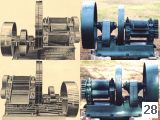 This composite image (Slide
28) includes a cut of a Golden horizontal power mill (feed side, upper
left; discharge side, lower left). This cut is from Golden Cat. No. 53
(1933), but it appears to be identical to one in Cat. No. 34 (~1916;
identical meaning down to the shading and brick spacing for the foundation).
This cut of a Goldens' No. 36 (New Model) is not an exact image of a Goldens'
No. 27 (New Model), but is sufficiently close for comparison with the mill on
the right, about which more below. Note the cut shows that the bearing
housing caps that secure the small rollers have four fasteners each in the
cut, but those of the Goldens' No. 27 (New Model) have only two each. The
mill on the right was made by Thomasville Iron Works, Thomasville, Georgia,
which was operated by a Mr. Thompson. (As one notes, the Thomasville Iron
Works mill is missing the discharge chute and the gear covering.) According
to Wesley Pope's cousin, that foundry once had a sign in front that read
"Golden Brothers Foundry," but Mr. Olin Pope does not remember such a sign.
At any rate, this Thomasville Iron Works mill was owned and used for years by
Olin Pope of Barwick, Georgia, and Mr. Olin's son, Wesley, worked on this
mill and rebuilt a Goldens' No. 27 (New Model) (Pope Photogallery, 6.4MB). Wesley wrote this comparison
of the Thomasville Iron Works mill and the Goldens' No. 27 (New Model): "The
only difference between the two mills is the configuration of the reduction
gearing and the height of the right and left hand housing units. The small
roll gear was housed on top of the spur gear on the Thomasville mill and side
by side on the Goldens'. The bases for both mills, including the pattern of
the hold down bolt holes, were the same-except for the placement of the
reduction gearing and housing units covering the gears. The right and left
hand roller housing units were the same, except the Thomasville units were 1"
higher below the small roll journal boxes than the Goldens'-all other parts
were interchangeable." Thanks to Wesley Pope for the information above and
thanks to Ken Christison, who corrected an error. Also, thanks to Anthony
Brinson, who points out that he has seen a mill exactly like the Pope mill,
except it was the size of a Goldens' No. 36 (New Model), and some of the
parts had been replaced by those of a No. 36 (identifiable by
number). This composite image (Slide
28) includes a cut of a Golden horizontal power mill (feed side, upper
left; discharge side, lower left). This cut is from Golden Cat. No. 53
(1933), but it appears to be identical to one in Cat. No. 34 (~1916;
identical meaning down to the shading and brick spacing for the foundation).
This cut of a Goldens' No. 36 (New Model) is not an exact image of a Goldens'
No. 27 (New Model), but is sufficiently close for comparison with the mill on
the right, about which more below. Note the cut shows that the bearing
housing caps that secure the small rollers have four fasteners each in the
cut, but those of the Goldens' No. 27 (New Model) have only two each. The
mill on the right was made by Thomasville Iron Works, Thomasville, Georgia,
which was operated by a Mr. Thompson. (As one notes, the Thomasville Iron
Works mill is missing the discharge chute and the gear covering.) According
to Wesley Pope's cousin, that foundry once had a sign in front that read
"Golden Brothers Foundry," but Mr. Olin Pope does not remember such a sign.
At any rate, this Thomasville Iron Works mill was owned and used for years by
Olin Pope of Barwick, Georgia, and Mr. Olin's son, Wesley, worked on this
mill and rebuilt a Goldens' No. 27 (New Model) (Pope Photogallery, 6.4MB). Wesley wrote this comparison
of the Thomasville Iron Works mill and the Goldens' No. 27 (New Model): "The
only difference between the two mills is the configuration of the reduction
gearing and the height of the right and left hand housing units. The small
roll gear was housed on top of the spur gear on the Thomasville mill and side
by side on the Goldens'. The bases for both mills, including the pattern of
the hold down bolt holes, were the same-except for the placement of the
reduction gearing and housing units covering the gears. The right and left
hand roller housing units were the same, except the Thomasville units were 1"
higher below the small roll journal boxes than the Goldens'-all other parts
were interchangeable." Thanks to Wesley Pope for the information above and
thanks to Ken Christison, who corrected an error. Also, thanks to Anthony
Brinson, who points out that he has seen a mill exactly like the Pope mill,
except it was the size of a Goldens' No. 36 (New Model), and some of the
parts had been replaced by those of a No. 36 (identifiable by
number).
 At the beginning of the 20th
century, Cairo (Georgia) was the center for shipping syrup out of the
surrounding region. This history is reflected in Cairo's high school, the
teams of which use the moniker syrupmakers (Slide
29). At the beginning of the 20th
century, Cairo (Georgia) was the center for shipping syrup out of the
surrounding region. This history is reflected in Cairo's high school, the
teams of which use the moniker syrupmakers (Slide
29).
_04_Feed_Reduced-t.jpg) Cane-mill expert Anthony
Brinson put me onto another mill made in Thomasville, Georgia (Slide 30; cf. Slide
28). This mill, made by Thompson Foundry and Machine Co. and owned by J.
Jones (Climax, Georgia), is apparently like the Goldens' No. 36 (New Model)
and, indeed, it has "36" cast in small letters under the rollers (see also
the News Sun). (Note that the pulley on the mill in Slide 30 is not
the original, which was lying by the mill. Also note that the beads welded
across the rollers were done by the Jones family to improve feeding of cane
stalks into the mill.) Anthony recalled that Mr. Amos Jones and Mr. Louis
Jones picked up the mill new in Columbus, Georgia, although it had been
bought from Mr. Thompson. Apparently, a number of power mills in south
Georgia are basically Goldens' mills, but were made by, or used replacement
parts from the Thompson or other foundries as indicated by differences in
details such as lubrication or thickness of parts. Thanks to Mr. Jones for
giving me access to the mill and discussing its history. (Finally, this brief
note would be incomplete if I did not note that my maternal grandmother's
mother was a Thompson, the daughter of Berry
C. Thompson, and this fact adds interest for me.) Cane-mill expert Anthony
Brinson put me onto another mill made in Thomasville, Georgia (Slide 30; cf. Slide
28). This mill, made by Thompson Foundry and Machine Co. and owned by J.
Jones (Climax, Georgia), is apparently like the Goldens' No. 36 (New Model)
and, indeed, it has "36" cast in small letters under the rollers (see also
the News Sun). (Note that the pulley on the mill in Slide 30 is not
the original, which was lying by the mill. Also note that the beads welded
across the rollers were done by the Jones family to improve feeding of cane
stalks into the mill.) Anthony recalled that Mr. Amos Jones and Mr. Louis
Jones picked up the mill new in Columbus, Georgia, although it had been
bought from Mr. Thompson. Apparently, a number of power mills in south
Georgia are basically Goldens' mills, but were made by, or used replacement
parts from the Thompson or other foundries as indicated by differences in
details such as lubrication or thickness of parts. Thanks to Mr. Jones for
giving me access to the mill and discussing its history. (Finally, this brief
note would be incomplete if I did not note that my maternal grandmother's
mother was a Thompson, the daughter of Berry
C. Thompson, and this fact adds interest for me.)
|
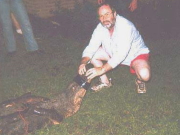
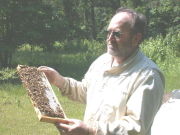
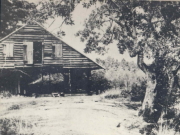
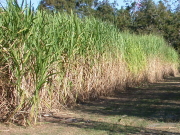
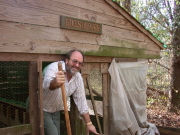
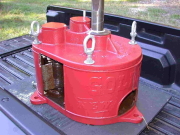


-t.jpg)
-t.jpg)

-t.jpg)

-t.jpg)
_(65)-t.jpg)
-t.jpg)

-t.jpg)


_04_Feed_Reduced-t.jpg)